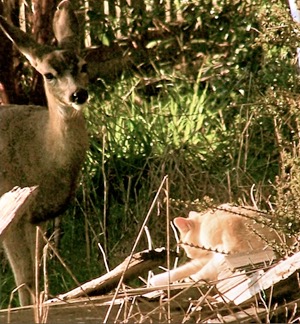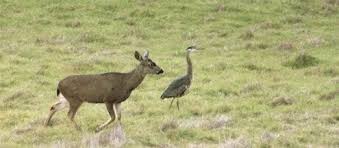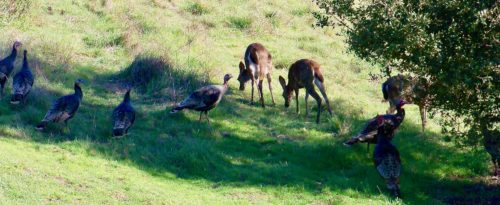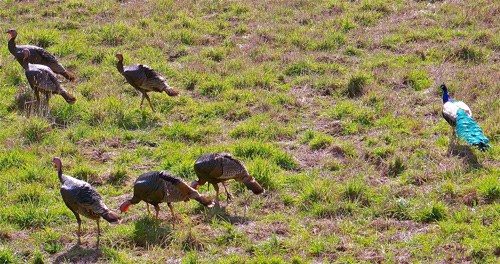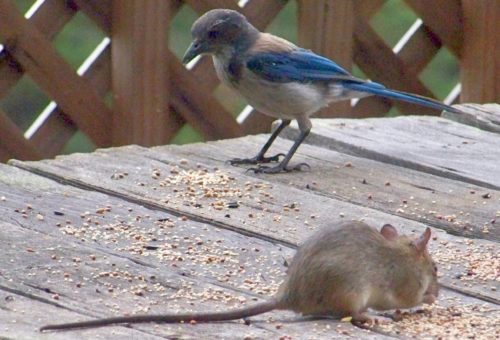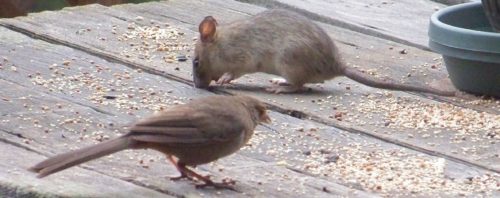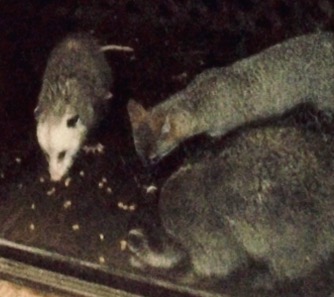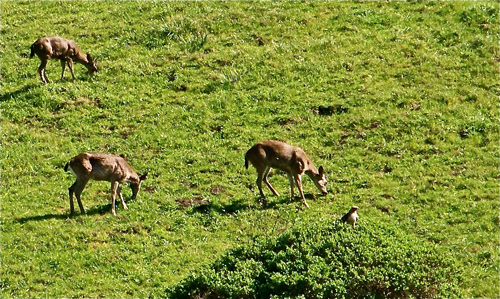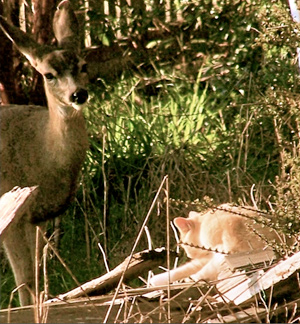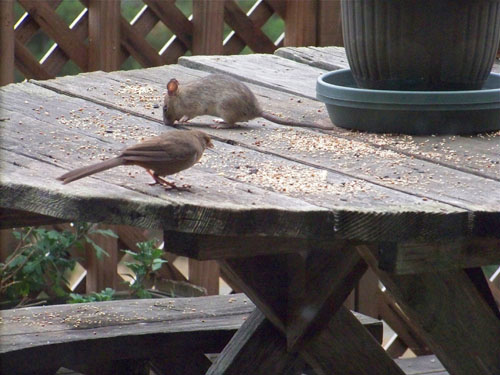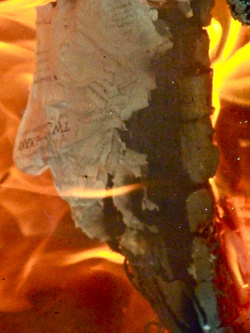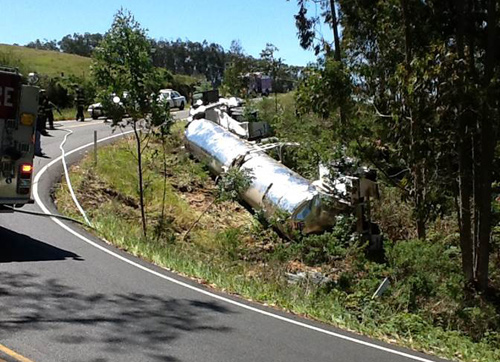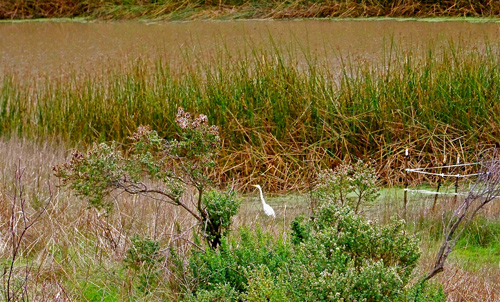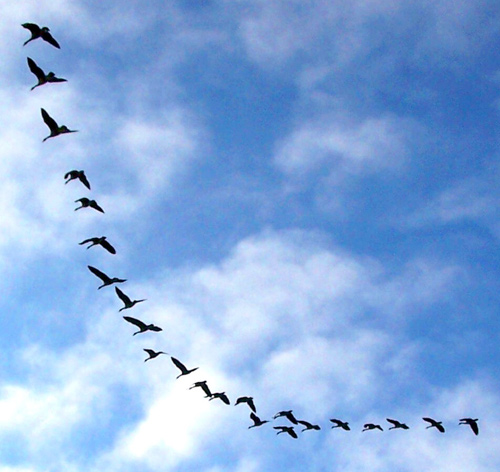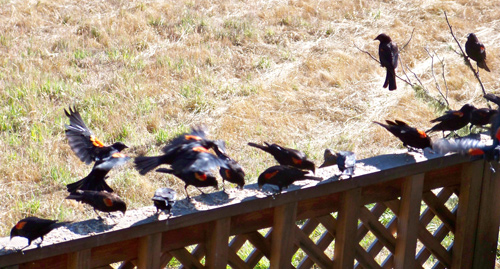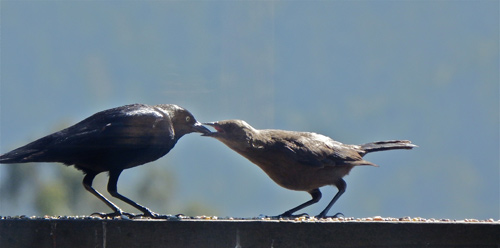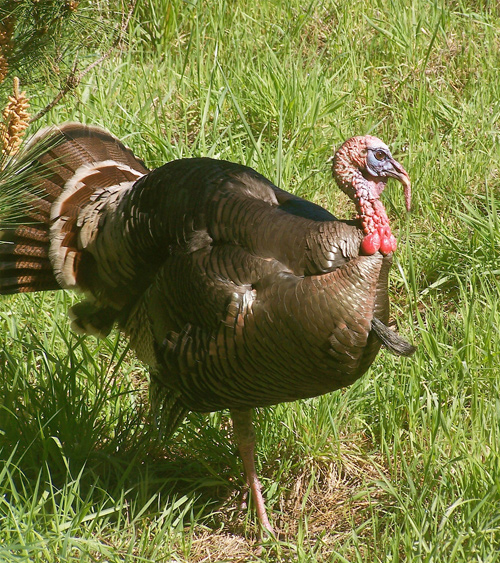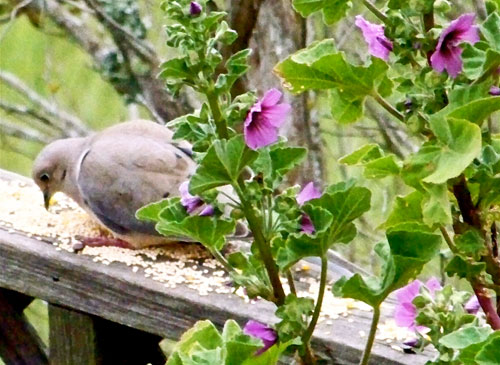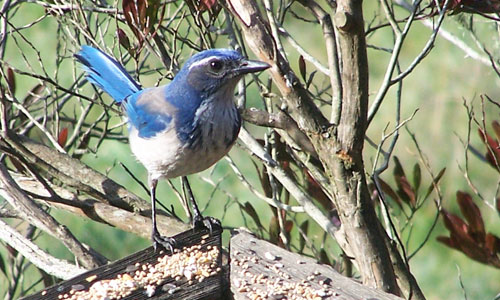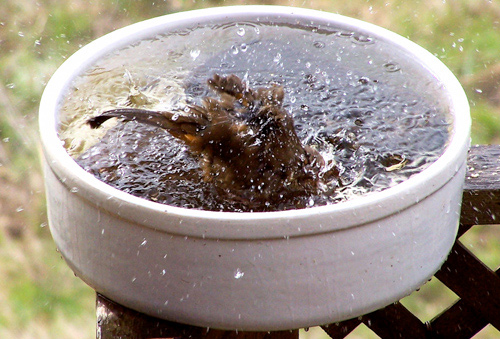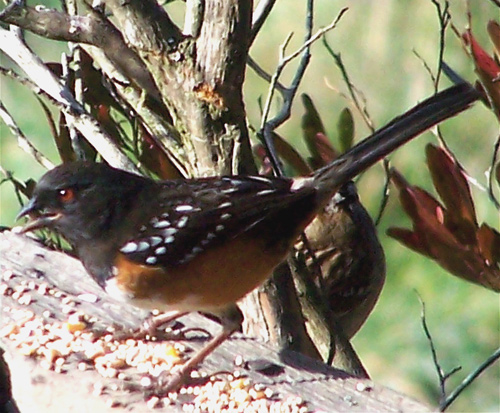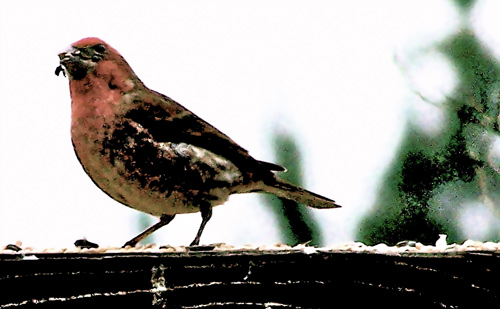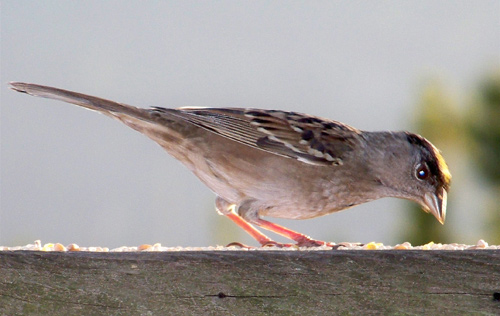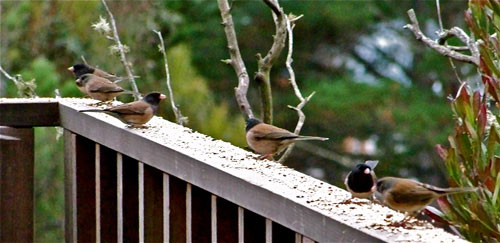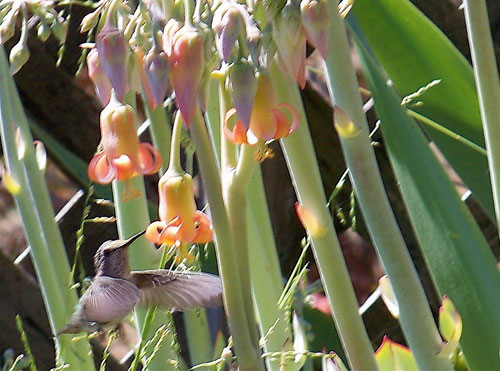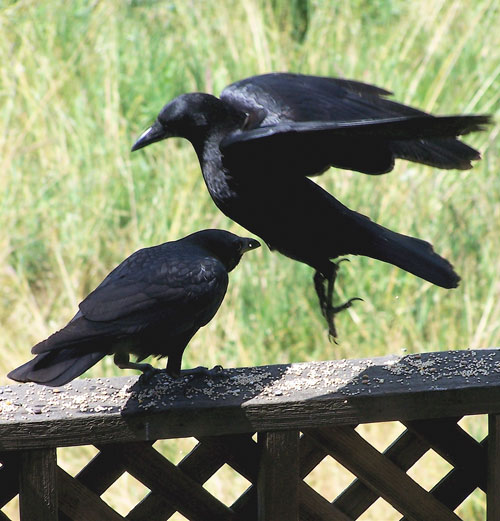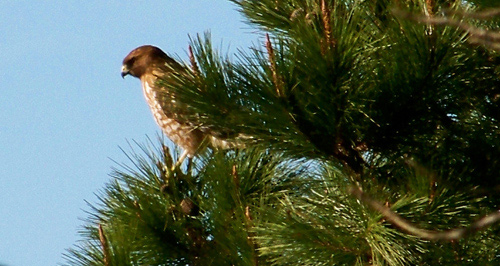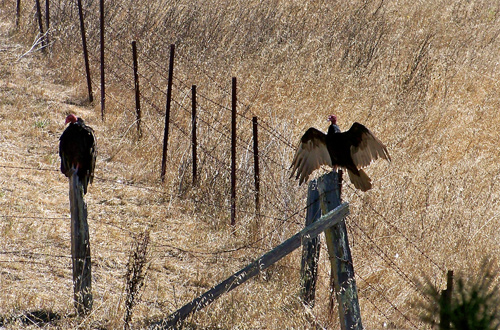Entries tagged with “towhee”.
Did you find what you wanted?
Wed 15 Jun 2022
Posted by DavidMitchell under History, Photography, Point Reyes Station, West Marin nature, Wildlife
Comments Off on Natural coexistence
Caveat lectorem: When readers submit comments, they are asked if they want to receive an email alert with a link to new postings on this blog. A number of people have said they do. Thank you. The link is created the moment a posting goes online. Readers who find their way here through that link can see an updated version by simply clicking on the headline above the posting.
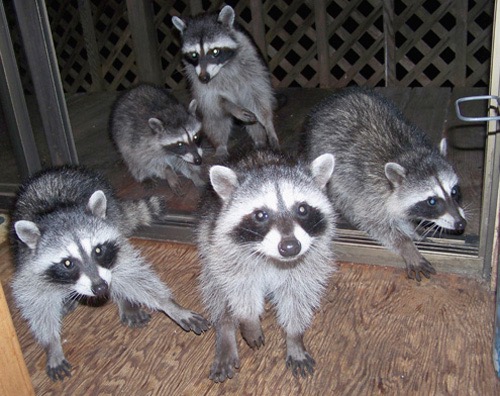
A family of raccoons enters the kitchen of Mitchell cabin in search of food. They were given some bread, but not in the kitchen.
Living in West Marin means living with nature. The surprise is how often nature manages to live with itself.

A blacktail buck and a bobcat foraging near each other on the hillside above Mitchell cabin. Each was aware of the other but didn’t seem to care.

A possum, fox, and raccoon eat kibble nose to nose just outside our kitchen door.
 Likewise dining side by side are this towhee and roof rat nibbling birdseed off our picnic table.
Likewise dining side by side are this towhee and roof rat nibbling birdseed off our picnic table.
 One surprising relationship went on for years around this part of town. This peacock was often seen in the company of a flock of wild turkeys. Unfortunately, I haven’t seen the peacock in recent months. I hope it’s okay. (Sad update: Obviously, not all species of wildlife are friendly toward each other, and the day after this posting went online, a neighbor told me a bobcat had killed the peacock.)
One surprising relationship went on for years around this part of town. This peacock was often seen in the company of a flock of wild turkeys. Unfortunately, I haven’t seen the peacock in recent months. I hope it’s okay. (Sad update: Obviously, not all species of wildlife are friendly toward each other, and the day after this posting went online, a neighbor told me a bobcat had killed the peacock.)
Just how close different species can live to each other was epitomized Tuesday evening. I had been lying on a couch in the living room listening to music when I got up and spotted a raccoon a few feet away eating kibble put out for our cat. The raccoon had managed to get inside because our kitchen door had been left open a few inches. It soon departed by the same route.
Tue 8 Oct 2019
Posted by DavidMitchell under West Marin nature, Wildlife
Comments Off on The charm of inter-species neighborliness
Caveat lectorem: When readers submit comments, they are asked if they want to receive an email alert with a link to new postings on this blog. A number of people have said they do. Thank you. The link is created the moment a posting goes online. Readers who find their way here through that link can see an updated version by simply clicking on the headline above the posting.
Some critters get along with their animal neighbors better than we might expect. Here’s a look at some inter-species neighborliness that’s caught my eye around Mitchell cabin.

A curious black-tailed doe watches a housecat clean itself.

A great blue heron goes gopher hunting near Mitchell cabin beside a grazing deer.

Seven wild turkeys hunt and peck alongside four black-tailed deer.

Wild turkeys, in fact, can often be found roaming around with other creatures, such as this lone peacock.

A scrub jay and a roof rat comfortably eat birdseed side by side on our picnic table.

Towhees are nowhere near as brazen as jays, but this one seems unconcerned about eating next to a roof rat.

Raccoons and skunks manage to dine together on our deck almost every night. As previously noted, raccoons, like dogs, identify each other by sniffing rear ends, including the backsides of skunks. The skunks often shoulder aside raccoons while competing for food but for some reason never spray them.

Another milepost in inter-species mingling: a possum, fox, and raccoon eat nose to nose to nose outside our kitchen door.
Sun 26 Apr 2015
Posted by DavidMitchell under General News, Marin County, West Marin nature, Wildlife
Comments Off on Birds, deer, a cat, a rat, a face in the flames, and another overturned truck
I’m always fascinated by how well some wildlife of different species get along with each other. Deer in particular seem to enjoy the company of other species.

I was reminded of this felicitous phenomenon when I spotted a hawk (lower right) keeping company with a small herd of deer grazing near Mitchell cabin. _____________________________________________________________
 A curious blacktail doe watches a house cat clean itself on a woodpile.
A curious blacktail doe watches a house cat clean itself on a woodpile.
I’ve also seen deer show similar interest in rabbits resting in my field.
_______________________________________________________

While another doe grazes, she keeps company with a great blue heron as the bird hunts gophers in my pasture.

A roof rat and a towhee eating birdseed side by side on our picnic table. It’s such a relaxed relationship that neither appears to notice the presence of the other. ________________________________________________________________
 Some things that happen around Mitchell cabin are more of a surprise.
Some things that happen around Mitchell cabin are more of a surprise.
Friday night I was lying on my side looking into my woodstove when I noticed a phantasmagorical head sticking out of the flames.
At first it appeared to be wrapped in newspaper headlines. Lynn, however, explained that she had used some discarded fundraising solicitation forms to light the fire.
____________________________________________________________

Yet another truck wreck in West Marin. A week ago Saturday, a truck and trailer rig hauling grocery supplies overturned on the Point Reyes-Petaluma Road, blocking traffic for nine hours.
Shortly before noon today, a milk truck overturned on Highway 1 near Nicks Cove, closing the highway for several hours. “The truck, heading south near Nicks Cove, failed to negotiate a turn and landed on its side along the highway,” said Mike Giannini, a battalion chief with Marin County Fire Department.
“The accident caused a hatch to fail and allow approximately 4,000 gallons of milk to be discharged from the tank. Additionally, about 100 gallons of diesel fuel was spilled. Firefighters were able to contain the diesel with absorbent materials.
“At the time of the accident, the milk was approximately 100 yards from Tomales Bay,” Giannini reported at 5 p.m. “Crews are continuing to monitor any possible threat to bay waters.
“The driver of the truck was evaluated by Marin County Fire Department paramedics and was transported to the hospital for evaluation. The exact cause of the accident is under investigation.”
All this is getting to be routine. Let’s see where next weekend’s truck wreck occurs.
Sun 18 Jan 2015
Here is a gallery of my bird photography, as was promised two weeks ago. The photos were all shot at Mitchell cabin or around it.

One reason Mitchell cabin gets quite a variety of birds and other wildlife is that its fields come within a few feet of a neighbor’s stockpond, where numerous creatures show up daily to drink or hunt. Here a common egret wades through shallow water, looking for frogs, small fish, or insects.

While it’s hunting, a great blue heron will repeatedly stand motionless and then use lightning-fast strikes with its sharp bill and long neck to catch gophers in Mitchell cabin’s fields or frogs and fish in the pond.

The cabin is under the commute route for Canada geese which travel daily between the Point Reyes National Seashore and the Marin French Cheese Factory’s ponds in Hicks Valley. It’s easy to tell when they’re coming; they honk as much as Homo sapiens commuters stuck in traffic.

A flock of tri-colored blackbirds swoop down onto the deck railing when Lynn or I spread a line of birdseed along it morning and evening. Many of the blackbirds nest in reeds at the pond.

Even after they’ve grown old enough to feed themselves, young blackbirds for awhile still want to be fed by their parents. Once in awhile the parents do oblige them, but over a few days, they wean their youngsters. (Photo by my partner Lynn Axelrod)

A tom turkey struts his stuff. In 1988, a hunting club working with the State Department of Fish and Game introduced non-native turkeys into West Marin on Loma Alta Ridge, which overlooks the San Geronimo Valley. By now there are far more turkeys than turkey hunters, and their flocks have spread throughout West Marin.

A little more than a year ago, a lone peacock showed up and soon began hanging out with a flock of wild turkeys. Months later, he can still be seen bringing up the rear as the flock hunts and pecks its way across the fields.

A male quail. Male and female quail both have crests. The males’ crests are black, the females, brown.

The Eurasian collared dove is a native of the Middle East that spread across Europe in the 20th Century, according to the Audubon Society. In 1974, it was accidentally introduced into the Bahamas. In the 1980s, the doves discovered the US was only a short flight away and began taking trips to Florida. In less than 30 years, the doves have spread throughout most of this country.

California western scrub jays show up immediately when we put seed on the railing.

A California towhee freshens up in the birdbath on the deck.

Rufous-sided towhees are among the most colorful birds that show up for birdseed.

A purple finch chews a sunflower seed it found among other seeds on the railing.

The presence of golden-crowned sparrows is often announced by their song, which sounds like Three Blind Mice in a minor key.

Oregon juncos keep a close eye on Mitchell cabin’s deck, and it’s never long after we put out birdseed that they begin showing up. They’re less skittish than most other birds and will sometimes begin pecking seeds off the railing before we’ve departed.

A female hummingbird. Hummingbirds drop by for drinks whenever we have flowers in bloom.

American crows, which are native to North America, are considered intelligent birds. Here, for example, they demonstrate their mastery of jitterbug.

A crow skins its caterpillar dinner in the birdbath.

Redtailed hawks dine on reptiles, small mammals, and birds. Their call is a two-or-three second scream which trails downward. Redtails are monogamous and typically reach sexual maturity at age two or three and can live to age 21 in the wild.

When I spotted this great-horned owl in a tree 200 feet or more from the cabin one evening, I decided to try photographing it. However, the light was so low that when I triggered the shutter, the little flash on my old-fashioned Kodak flipped open and fired. To my amazement, the flash was reflected in the owl’s eyes despite the bird’s distance from me. With eye shine (see tapetum lucidum) like that, it’s no wonder owls can see well in the dark.

Two buzzards warming themselves in the morning sun.
This gallery doesn’t include all the birdlife around Mitchell cabin, of course, but it’s a sampling of our avian neighbors. They’re not the only reason I enjoy living where I do, but they’re a big part of it.
Tags: American crow, buzzards, California western scrub jay, Canada geese, common egret, Eurasian collared dove, Golden-crowned sparrow, Great blue heron, great-horned owl, purple finch, quail, redtailed hawk, Rufous-sided towhee, towhee, Tricolored Blackbirds, wild turkeys

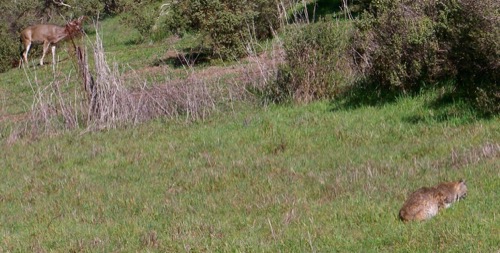
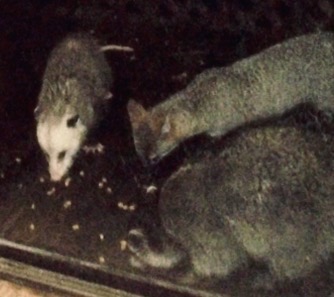
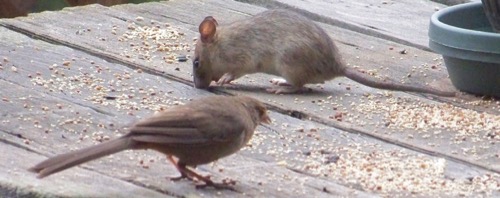 Likewise dining side by side are this towhee and roof rat nibbling birdseed off our picnic table.
Likewise dining side by side are this towhee and roof rat nibbling birdseed off our picnic table.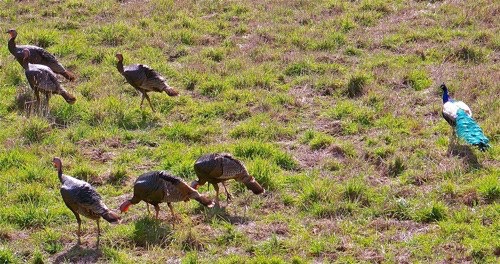 One surprising relationship went on for years around this part of town. This peacock was often seen in the company of a flock of wild turkeys. Unfortunately, I haven’t seen the peacock in recent months. I hope it’s okay. (Sad update: Obviously, not all species of wildlife are friendly toward each other, and the day after this posting went online, a neighbor told me a bobcat had killed the peacock.)
One surprising relationship went on for years around this part of town. This peacock was often seen in the company of a flock of wild turkeys. Unfortunately, I haven’t seen the peacock in recent months. I hope it’s okay. (Sad update: Obviously, not all species of wildlife are friendly toward each other, and the day after this posting went online, a neighbor told me a bobcat had killed the peacock.)
